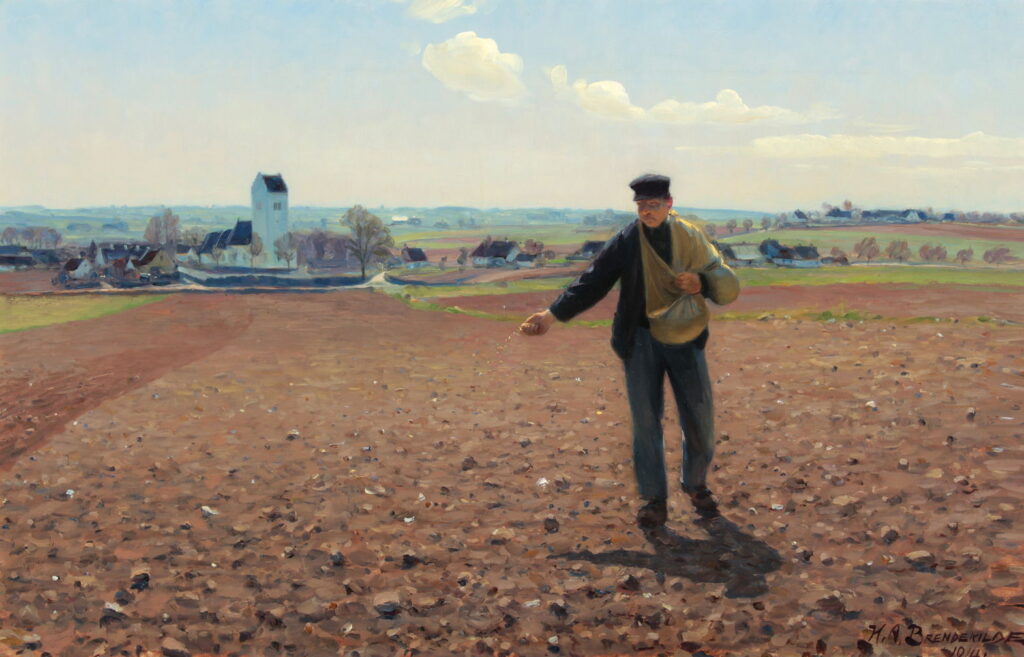The Real Country: 2 The sower

For countless generations, since humans first started farming the land, improving the soil and fields has been a constant task. Once the plough has passed, there’s still work to be done in many areas, where there are stones mixed in the soil. This has been the burden of those who have worked the land, and has been featured in occasional paintings.
Hans Andersen Brendekilde (1857–1942), Worn Out (1889), oil on canvas, 207 x 270 cm, Fyns Kunstmuseum, Odense, Denmark. Wikimedia Commons.
Hans Andersen Brendekilde’s Worn Out (1889) follows in the Naturalist tradition of Jules Bastien-Lepage. An old man has collapsed when working in the fields. A younger woman, his daughter perhaps, is giving him aid and shouting for all she’s worth to summon assistance. The soil around them is poor, and full of flints; the two were engaged in the toil of the poorest of the poor, picking out the large stones and putting them into piles for collection. It’s backbreaking work for the young, and clearly proved too much for this man.
Once ploughed to a fine tilth and rid of its stones, the soil is ready for the seed of the next crop, accomplished by manual broadcasting, a term in common use long before it came to be applied to radio then TV transmissions.
Sowing is one of the basic tasks in arable farming, and one at the heart of the changes that took place between 1600 and 1900. Broadcasting is tedious, time-consuming and inefficient in use of seed, making it one of the first tasks for attempts to mechanise farming. Although early types of seed drill had been tried before, it’s Jethro Tull, an English gentleman farmer from the early eighteenth century, who has generally been credited with inventing the first successful seed drill, in 1701. Today his name is better-known as that of one of the great rock bands formed in 1967.
Alongside the use of a seed drill was the requirement for a horse hoe, a light and small plough drawn by a single horse, to ensure the seed was well covered by soil. Unfortunately, early drills proved too fragile for general use, and it wasn’t until the early nineteenth century that metal could be turned to manufacture more durable drills, that became widespread across Western Europe during the rest of that century. However, contemporary painting continued to show sowers still broadcasting seed.
Jean-François Millet (1814–1875), The Sower (1850), oil on canvas, 101.6 x 82.6 cm, Museum of Fine Arts, Boston, MA. Wikimedia Commons.
The first of these is Jean-François Millet’s The Sower, completed in 1850, shown at the Salon that year and now recognised as his first real masterpiece. It shows an agricultural worker striding across a field, broadcasting seed for the summer’s crop. In the distance to the right, and caught in the sunlight, is another worker harrowing with a pair of oxen. This was being used to ensure the seed sown was covered with soil, and not exposed to the flurry of birds trying to eat any seed left on the surface.
Jean-François Millet (1814–1875), The Sower (c 1865), pastel and crayon on paper or pastel and pastel on paper (cream buff paper), 43.5 × 53.5 cm, Walters Art Museum, Baltimore, MD. Wikimedia Commons.
Millet revisited his successful painting of a sower from fifteen years earlier, here with two pastel paintings with the same title, The Sower, from around 1865. That above is now in the Walters, and that below in the Clark. These feature a different background, including the tower of Chailly, harrowing using a pair of horses, and a swirling flock of crows in the sky.
Jean-François Millet (1814–1875), The Sower (1865-66), pastel and crayon on beige wove paper mounted on board (Conté crayon, wood-pulp board), 47.1 × 37.5 cm, Sterling and Francine Clark Art Institute, Williamstown, MA. Wikimedia Commons.
By the late nineteenth century, manual broadcasting was becoming less common as farms turned to seed drills, but the image of the sower continued to appear in paintings.
Hans Thoma (1839–1924), Säender Bauer (Heavy Shower) (1886), oil on canvas, 60.5 × 73 cm, location not known. Wikimedia Commons.
The title of Hans Thoma’s Säender Bauer (1886) is, I think, best translated as Heavy Shower. A sower in Millet’s tradition is at work in the ploughed field in the foreground. Beyond, the heavens have opened in a sudden downpour. Two years later, when he was living in Arles in November 1888, Vincent van Gogh painted his version of The Sower.
Albin Egger-Lienz (1868–1926), The Sower (1903), oil on canvas, 177 x 156 cm, Museum Schloss Bruck, Lienz, Austria. Wikimedia Commons.
Millet’s influence is also manifest in the first of Albin Egger-Lienz’s versions of The Sower, from 1903, a motif which was to recur in his later works. Its earth colours, increasing looseness, and emphasis on simplicity were to set the style for much of the rest of his career.
Laurits Andersen Ring (1854–1933), The Sower (1910), oil on canvas, 186.5 x 155.5 cm, Statens Museum for Kunst (Den Kongelige Malerisamling), Copenhagen, Denmark. Wikimedia Commons.
Laurits Andersen Ring admired Millet’s social realism, and would undoubtedly have seen at least one of Millet’s depictions of this motif. In 1910, Ring painted this, The Sower, in such great detail that you can see every seed frozen in mid-air. This suggests that he may have been influenced by photography, the first means of producing such images.
Hans Andersen Brendekilde (1857–1942), A Sower on a Sunny Spring Day at Brendekilde Church (1914), oil on canvas, 49 x 76 cm, Private collection. Wikimedia Commons.
Ring’s friend and contemporary Hans Andersen Brendekilde responded in 1914 with A Sower on a Sunny Spring Day at Brendekilde Church. This is thought to show Holme-Olstrup Church, near Næstved on the island of Sjælland (Zealand), close to where Brendekilde was born and from where he had taken his name. The sower, walking over poor soil with abundant stones, has been identified as Ole Frederik Jensen (1870-1953).
This motif seems to have long outlasted the practice of broadcasting. By 1900, even gardeners and smallholders were being offered mechanical seed drills. As those used less than a third of the seed than broadcasting, it’s hard to see any farmer in the early twentieth century still preferring traditional methods.
With the young plants growing vigorously, all that remained for the growing season was to keep them free from weeds, another laborious and back-breaking task often assigned to women.
Jules Breton (1827–1906), The Weeders (1868), oil on canvas, 71.4 × 127.6 cm, The Metropolitan Museum of Art, New York, NY. Wikimedia Commons.
The Weeders (1868) is a smaller variant of a painting of the same name that Jules Breton made in 1860, which was acclaimed when exhibited in the Salon the following year and the Exposition Universelle in 1867. Set in the fields just outside Courrières, the labourers are pulling up thistles and other weeds until the last moment that there is insufficient light for them to work any longer. Breton wrote of their faces encircled by the pink transparency of their violet bonnets, as if worshipping the life-giving star.
Although only peasants, the light transforms these women into classical beauties, an observation made by the critics at the time. This gives rise to a phenomenon repeated across Breton’s panoramas of country work, in which these classical figures appear in thoroughly socially-realist landscapes, showing their sanctity in labour.
Jakub Schikaneder (1855–1924), Plečka (Weeder) (1887), further details not known. Wikimedia Commons.
Jakub Schikaneder’s Weeder (1887) shows a woman bent double as she pulls weeds from a young crop, and would pass for a social realist work from the likes of Millet or Breton.




